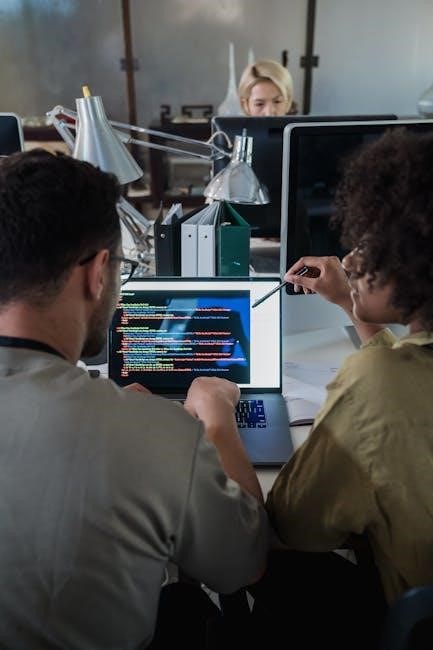Team development is a crucial process that enhances collaboration and productivity. Understanding stages like Forming, Storming, Norming, and Performing helps leaders guide teams effectively.
1.1 Definition of Team Development
Team development refers to the process by which a group of individuals evolves into a cohesive unit, progressing through stages like Forming, Storming, Norming, Performing, and Adjourning. It involves enhancing collaboration, communication, and productivity to achieve shared goals. According to Tuckman’s model, these stages are essential for building trust, resolving conflicts, and maximizing team potential. Effective team development is crucial for leadership and organizational success, enabling teams to adapt and grow over time.
1.2 Importance of Understanding Team Dynamics
Understanding team dynamics is essential for fostering collaboration, resolving conflicts, and maximizing productivity. By recognizing how individuals interact and contribute, leaders can tailor strategies to enhance communication and trust. Tuckman’s model emphasizes that each stage of team development presents unique challenges, such as conflict resolution during Storming or role clarification during Forming. Awareness of these dynamics enables leaders to address issues proactively, align team goals with organizational objectives, and create an environment where members thrive collectively, leading to improved outcomes and sustained success.
1.3 Overview of Tuckman’s Model
Bruce Tuckman’s model outlines the progression of teams through five distinct stages: Forming, Storming, Norming, Performing, and Adjourning. Each stage represents a critical phase in team development, from initial formation to eventual disbandment. The model provides a framework for understanding the natural evolution of group dynamics, helping leaders anticipate challenges and foster growth. By recognizing these stages, organizations can better support teams in building trust, resolving conflicts, and achieving high performance, ultimately enhancing collaboration and productivity.

Forming Stage
The Forming stage is where team members first come together, establishing roles and goals. It’s marked by initial interactions and setting the foundation for future collaboration and trust-building.
2.1 Definition and Characteristics
The Forming Stage is the initial phase of team development where members first come together. It is characterized by uncertainty, as roles and responsibilities are unclear. Team members often exhibit polite behavior, avoiding conflict to maintain harmony. The leader plays a pivotal role in setting direction and building trust. This stage is marked by a sense of excitement and nervousness as individuals assess their place within the group. Open communication is limited, but foundational relationships begin to form.
2.2 Challenges in the Forming Stage
During the Forming Stage, teams face challenges such as unclear roles and responsibilities, leading to confusion and hesitation. Members may be hesitant to share ideas, fearing judgment or rejection. There is a lack of trust and cohesion, making collaboration difficult. Additionally, dependency on the leader for guidance can hinder independent decision-making. Teams may also struggle with differing expectations and goals, requiring the leader to actively facilitate communication and clarify objectives to move beyond this initial phase of uncertainty and doubt.
2.3 Strategies for Effective Team Formation
Effective team formation requires clear communication and defined roles to reduce confusion. Leaders should foster an open environment where members feel safe sharing ideas. Icebreakers and team-building activities can help establish trust and cohesion. Providing clear goals and expectations aligns the team and encourages collaboration. Regular feedback and active listening by leaders help address concerns early. Encouraging participation from all members ensures diverse perspectives are valued, setting a strong foundation for future stages of team development and enhancing overall productivity. These strategies promote a positive and productive team culture from the outset.

Storming Stage
The Storming Stage is marked by conflict and resistance as team members assert their identities. Overcoming disagreements strengthens the team’s dynamics and fosters collaboration.
3.1 Understanding Conflict and Resistance
The Storming stage is marked by conflict and resistance as team members challenge each other’s ideas and authority. This phase often leads to power struggles and disagreements, which can hinder progress. Team members may resist new roles or responsibilities, causing tension within the group. While this can be challenging, it’s a natural part of building trust and clarity. Leaders must address these conflicts constructively to guide the team toward collaboration and shared goals, ensuring the Storming phase leads to growth rather than stagnation.
3.2 Managing Disagreements and Power Struggles
During the Storming stage, managing disagreements and power struggles requires strong leadership. Open communication should be encouraged to address conflicts constructively. Leaders must remain impartial, fostering an environment where all voices are heard. Establishing clear expectations and roles can reduce power struggles. Active listening and mediation can help resolve disputes, promoting understanding and collaboration. Redirecting the team’s focus toward shared goals can minimize resistance and keep the group moving forward productively; Effective management during this phase is crucial for building trust and cohesion.
3.3 Building Trust During the Storming Phase
Trust is tested and strengthened during the Storming phase as team members navigate conflicts. Encouraging open communication and active listening fosters transparency. Leaders should remain impartial, ensuring all perspectives are valued. Consistency in decision-making and clear expectations help build reliability. Recognizing individual contributions and progress, no matter how small, reinforces trust. This phase is critical for establishing a foundation of mutual respect, which is essential for transitioning into the Norming stage. Trust becomes the glue that holds the team together, enabling collaboration and shared accountability.

Norming Stage
The Norming stage is where teams establish clear roles, collaborate effectively, and trust deepens. Open communication and shared goals align the group, fostering a cohesive and resilient team.
4.1 Establishing Roles and Responsibilities
Defining clear roles and responsibilities is essential for team cohesion. During the norming stage, team members identify their strengths and align them with tasks. Leaders should use tools like RACI matrices to assign duties, ensuring accountability. This clarity reduces overlaps and conflicts, fostering a collaborative environment. As roles become defined, trust and coordination improve, enabling the team to focus on shared goals. Effective role establishment is a cornerstone of Tuckman’s norming stage, promoting efficiency and productivity.
4.2 Developing Team Cohesion and Collaboration
During the norming stage, teams focus on building trust and improving communication through open dialogue, encouraging shared ideas and mutual respect. Leaders facilitate collaboration via team-building activities, strengthening bonds and aligning individual goals with team objectives. This fosters a cohesive unit where collaboration thrives, enhancing performance and creating a positive, problem-solving oriented work environment that supports innovation, collective success, and effective decision-making, while reducing potential conflicts.
4.3 Encouraging Open Communication
Open communication is vital for team success, fostering transparency and trust. Leaders should create safe spaces for dialogue, encouraging active listening and candor. By promoting regular feedback and transparent decision-making, teams can address concerns promptly and align on shared goals. Encouraging diverse perspectives and constructive criticism strengthens collaboration and innovation. Open communication also helps resolve conflicts effectively, ensuring a productive and inclusive team environment that supports collective growth and success, aligning with Tuckman’s model of team development stages.

Performing Stage
The Performing stage is where teams achieve peak productivity, collaboration, and problem-solving. Roles are clear, trust is high, and the team operates seamlessly, delivering high-quality results efficiently.
5.1 Achieving High Performance and Productivity
In the Performing stage, teams achieve high performance and productivity. Collaboration is seamless, roles are clear, and communication is effective. Leaders empower members, fostering innovation and accountability. Alignment with organizational goals ensures focused efforts, driving success. Shared vision and cohesion maximize output, making this stage the pinnacle of team development.
5.2 Leveraging Team Strengths and Skills
Leveraging team strengths and skills is vital in the Performing stage. Leaders identify and utilize each member’s unique abilities, enhancing overall performance. Recognizing individual skills fosters a culture of empowerment and collaboration. Teams thrive when roles align with strengths, leading to improved innovation and problem-solving. Cross-training and skill-sharing further boost efficiency, ensuring all members contribute effectively. This strategic approach maximizes potential, driving sustained success and continuous team growth.
5.3 Sustaining Motivation and Engagement
Sustaining motivation and engagement is critical in the Performing stage. Recognizing achievements and providing opportunities for growth keeps teams inspired. Empowering members to take ownership of their work fosters accountability and satisfaction. Clear communication and transparent feedback ensure alignment with goals, boosting morale. Celebrating successes and addressing challenges promptly maintains enthusiasm. A positive work environment, coupled with meaningful recognition, ensures sustained engagement and high performance. Leadership plays a key role in nurturing motivation, enabling teams to thrive and achieve long-term success.

Adjourning Stage
Sustaining motivation and engagement is essential in the Performing stage. Recognize achievements and provide growth opportunities to keep teams inspired. Empower members to own their work, fostering accountability and satisfaction. Clear communication and feedback align goals, boosting morale. Celebrate successes and address challenges promptly to maintain enthusiasm. A positive environment with meaningful recognition ensures sustained engagement and high performance. Leadership nurtures motivation, enabling teams to thrive and achieve long-term success.
6.1 Preparing for Team Disengagement
Preparing for team disengagement involves transitioning members to new roles and documenting achievements. Leaders should ensure knowledge transfer and celebrate contributions to maintain morale. Emotional closure is crucial, as members may feel sadness or loss. Clear communication about next steps helps ease the transition. Recognizing the team’s impact fosters pride and closure. This stage is vital for preserving legacy and supporting individuals as they move forward. Effective disengagement ensures a smooth end to the team’s journey while setting members up for future success.
6.2 Reflecting on Team Achievements
Reflecting on team achievements is essential for recognizing progress and celebrating successes. This stage involves documenting milestones, acknowledging contributions, and sharing experiences. Leaders should highlight how goals were met and skills were developed. Reflection fosters a sense of pride and accomplishment, reinforcing team cohesion. It also provides insights for future improvements and motivates members for upcoming challenges. Celebrating achievements ensures that efforts are valued and builds a positive legacy for the team. This step strengthens morale and encourages continued growth beyond the current project or cycle.
6.3 Transitioning to New Opportunities
Transitioning to new opportunities is a natural phase after a team’s objectives are met. It involves reassigning roles, redistributing resources, and preparing members for future challenges. Leaders should facilitate smooth transitions by providing support and clarity. This phase ensures that team members are ready to adapt to new environments while maintaining their skills and experiences. Transitioning also allows for knowledge transfer and the application of lessons learned to upcoming projects. It marks the end of one cycle while paving the way for new beginnings and continued professional development. This step is vital for sustaining long-term growth and organizational success.

The Importance of Understanding Team Development Stages
Understanding team development stages is crucial for effective leadership and collaboration. It helps identify challenges, align goals, and enhance productivity, ensuring teams grow and succeed cohesively.
7.1 Aligning Team Goals with Organizational Objectives
Aligning team goals with organizational objectives ensures unity of purpose and direction. This integration enables teams to contribute effectively to broader organizational success. By understanding Tuckman’s stages, leaders can tailor strategies to align team efforts with organizational aims. During the forming stage, setting clear goals helps establish purpose. In the storming phase, fostering collaboration ensures alignment with organizational priorities. As teams progress through norming and performing stages, continuous communication and feedback reinforce goal alignment. Effective leadership plays a crucial role in maintaining this harmony, ensuring teams remain focused on organizational objectives throughout their development journey.
7.2 Identifying Key Milestones in Team Growth
Identifying key milestones in team growth helps track progress through Tuckman’s stages. The forming stage milestone is when trust begins to build among members. In the storming phase, resolving conflicts marks a turning point. The norming stage is complete when collaboration and cohesion are established. Finally, the performing stage is achieved when the team consistently delivers high performance. Recognizing these milestones allows leaders to celebrate achievements and address gaps, ensuring steady growth and alignment with organizational goals. This structured approach fosters a culture of continuous improvement and accountability.
7.3 Enhancing Leadership Skills Through Each Stage
Leadership skills evolve as teams progress through Tuckman’s stages. During forming, leaders must foster open communication and clarify roles. In the storming phase, conflict resolution and emotional intelligence are critical. Norming requires empowering members and encouraging collaboration. Performing demands strategic guidance and delegation. Adjourning involves reflection and transition planning. By adapting their approach to each stage, leaders can effectively support their team’s growth, enhance trust, and drive success. This dynamic leadership ensures teams remain motivated and aligned with organizational objectives throughout their development journey.

Leadership Roles in Team Development
Leaders play a crucial role in guiding teams through developmental stages, ensuring alignment with goals, fostering collaboration, and adapting strategies to support growth and success.
8.1 Facilitating the Forming Stage
Facilitating the forming stage involves creating a supportive environment where team members can orient themselves and establish initial connections. Leaders should encourage open communication, clarify roles, and set expectations to reduce anxiety. By fostering a positive tone, leaders help team members feel secure and approved, laying the groundwork for trust and collaboration. This stage is critical for building the foundation of a cohesive team, enabling smoother transitions into subsequent stages of development.
8.2 Managing Conflict During the Storming Stage
Conflict arises during the storming stage as team members assert their opinions and compete for influence. Leaders must address disagreements constructively by fostering open dialogue and active listening. Encouraging diverse perspectives while setting clear expectations can mitigate power struggles. Establishing ground rules for respectful communication helps navigate this challenging phase. Effective conflict management strengthens team cohesion and trust, enabling the group to progress toward the norming stage with improved collaboration and shared goals.
8.3 Empowering Team Members in the Norming Stage
During the norming stage, leaders should empower team members by delegating responsibilities and encouraging autonomy. This fosters a sense of ownership and accountability, enhancing team cohesion and collaboration. Providing constructive feedback and recognizing individual contributions motivates members to excel. Leaders should also focus on developing skills and promoting open communication to ensure continued growth. Empowerment during this stage strengthens trust and prepares the team for the performing stage, where high productivity and efficiency are achieved through effective teamwork and shared leadership.
8.4 Leading High-Performing Teams
Leading high-performing teams requires a strategic approach to maintain momentum and sustain success. Leaders should focus on clear communication, setting measurable goals, and leveraging each member’s strengths. Regular feedback sessions and recognition of achievements keep the team motivated. Encouraging continuous learning and adaptability ensures the team remains competitive. By fostering a culture of innovation and collaboration, leaders can drive their teams to achieve exceptional results and maintain a high level of performance over time, aligning with organizational objectives for long-term success.

Maintaining Team Health and Productivity
Maintaining team health involves monitoring progress, addressing burnout, and fostering a positive culture to ensure sustained productivity and engagement throughout all development stages, enhancing overall team success.
9.1 Monitoring Progress Through Each Stage
Monitoring progress through each stage of team development ensures alignment with goals and identifies areas for improvement. Leaders should assess milestones, communication, and collaboration. During the forming stage, focus on building trust and clarifying roles. In the storming stage, address conflicts and encourage open dialogue. The norming stage requires fostering cohesion, while the performing stage involves optimizing productivity. Regular feedback and adjustments help maintain momentum. This proactive approach supports team growth and ensures long-term success, fostering a culture of continuous improvement and accountability.
9.2 Addressing Team Member Burnout
Addressing team member burnout is essential for maintaining productivity and well-being. Leaders should identify early signs, such as decreased motivation or increased absenteeism. Encouraging work-life balance, recognizing contributions, and providing mental health resources can help mitigate burnout. Offering flexible work arrangements and ensuring realistic workload expectations are also critical. Creating an open dialogue about stress and fatigue fosters a supportive environment. Proactively addressing burnout strengthens team resilience and sustains long-term performance, ensuring members remain engaged and motivated throughout the team development stages.
9.3 Fostering a Positive Team Culture
Fostering a positive team culture involves creating an environment of trust, respect, and inclusivity. Leaders should encourage open communication, recognize individual contributions, and promote collaboration. Building a culture of empathy and support helps team members feel valued and connected. Celebrating successes and learning from failures collectively strengthens team bonds. A positive culture enhances engagement, creativity, and overall performance, ensuring teams thrive across all development stages. By prioritizing psychological safety and shared goals, leaders can cultivate a culture that sustains motivation and fosters long-term success.

Recognizing Team Development Stages in Practice
Recognizing team development stages in practice involves assessing the team’s progress, identifying challenges, and adapting strategies to align with their current phase of growth and collaboration.
10.1 Identifying Current Stage of Team Development
Identifying the current stage of team development involves observing team behavior, communication, and productivity. Leaders can assess whether the team is in Forming, Storming, Norming, or Performing by evaluating collaboration, conflict resolution, and goal achievement. Tools like Tuckman’s model provide frameworks to recognize these stages accurately, ensuring tailored strategies for growth and improvement. Recognizing the stage helps in addressing specific challenges and fostering a conducive environment for team success.
10.2 Anticipating Challenges in Each Stage
Anticipating challenges in each stage of team development is essential for effective leadership. In the Forming stage, uncertainty and role clarity are common issues. The Storming stage often brings conflict and resistance to ideas. During Norming, teams may struggle with complacency or over-reliance on consensus. In the Performing stage, challenges include maintaining motivation and adapting to changes. Finally, the Adjourning stage involves managing separation and celebrating achievements. By understanding these potential challenges, leaders can proactively implement strategies to address them, ensuring smoother team progression and success.
10.3 Adapting Strategies for Different Teams
Adapting strategies for different teams is crucial to maximize effectiveness. Each team has unique dynamics, goals, and member personalities, requiring tailored approaches. For instance, smaller teams may benefit from more direct communication, while larger teams need structured processes. Leadership styles should also flex, with some teams responding better to collaborative leadership and others to decisive direction. Additionally, strategies should align with the team’s industry, culture, and specific challenges. By customizing approaches, leaders can foster greater engagement, productivity, and overall success, ensuring each team thrives in its unique context.
Practical Applications of Tuckman’s Model
Tuckman’s Model is widely applied in workplace teams, project management, and education to guide team formation, conflict resolution, and performance improvement, enhancing overall collaboration and success.
11.1 Implementing the Model in Workplace Teams
Implementing Tuckman’s model in workplace teams involves guiding them through Forming, Storming, Norming, and Performing stages. Leaders play a key role in fostering trust and communication during Forming. In the Storming stage, addressing conflicts and power struggles is crucial. Norming focuses on collaboration and role clarity, while Performing emphasizes productivity and empowerment. By aligning team goals with organizational objectives, leaders can enhance cohesion and effectiveness, ensuring teams thrive in dynamic work environments.
11.2 Using the Model for Project Management
Tuckman’s model is invaluable for project management, as it aligns team development stages with project phases. During Forming, teams clarify roles and goals, ensuring alignment with project objectives. The Storming stage helps identify and resolve conflicts early, preventing delays. Norming fosters collaboration and shared accountability, enhancing efficiency. In Performing, high-performing teams execute tasks effectively. By understanding these stages, project leaders can allocate resources better, manage risks, and maintain motivation, ensuring successful project outcomes and alignment with organizational goals.
11.3 Applying the Model in Educational Settings
Tuckman’s model is highly applicable in educational environments to enhance group dynamics among students. During the Forming stage, educators can facilitate icebreakers to help students acquainted and establish clear objectives. In the Storming stage, teachers can guide students through conflicts, encouraging open dialogue to foster understanding. The Norming stage allows for collaborative learning experiences, where students develop shared goals and mutual respect. Finally, the Performing stage enables students to work cohesively on complex projects, applying their collective skills effectively; By understanding these stages, educators can better support student collaboration and improve learning outcomes.
Tuckman’s model highlights the importance of understanding team dynamics, guiding leaders through each stage to foster collaboration, resolve conflicts, and ultimately achieve high-performing teams.
12.1 Summary of Team Development Stages
The stages of team development, as outlined by Tuckman, include Forming, Storming, Norming, Performing, and Adjourning. Each stage represents a critical phase in a team’s growth, from initial formation to eventual disengagement. Understanding these stages helps leaders anticipate challenges and foster effective collaboration. The Forming stage lays the foundation, while Storming addresses conflicts. Norming builds trust, Performing maximizes productivity, and Adjourning ensures a smooth transition. Recognizing these phases is essential for aligning team goals with organizational objectives and enhancing overall performance.
12.2 Final Thoughts on Effective Team Leadership
Effective team leadership is rooted in understanding and navigating the stages of team development. Leaders must adapt their strategies to guide teams through Forming, Storming, Norming, Performing, and Adjourning. By fostering open communication, addressing conflicts, and empowering members, leaders can enhance collaboration and productivity. The ability to recognize and respond to each stage ensures alignment with organizational goals. Ultimately, successful leadership in team development requires patience, adaptability, and a commitment to continuous growth, enabling teams to thrive and achieve their full potential.
12.3 Encouragement for Continuous Team Growth
Encouraging continuous team growth fosters resilience, adaptability, and innovation. Leaders should motivate teams to embrace challenges and celebrate progress, aligning growth with organizational goals. Recognizing achievements and providing feedback reinforces commitment. Investing in learning opportunities and promoting open communication cultivates a culture of improvement. Empowering team members to take ownership of their development ensures sustained growth. Continuous growth not only enhances performance but also strengthens team cohesion, preparing them to thrive in evolving environments and achieve long-term success collectively.
